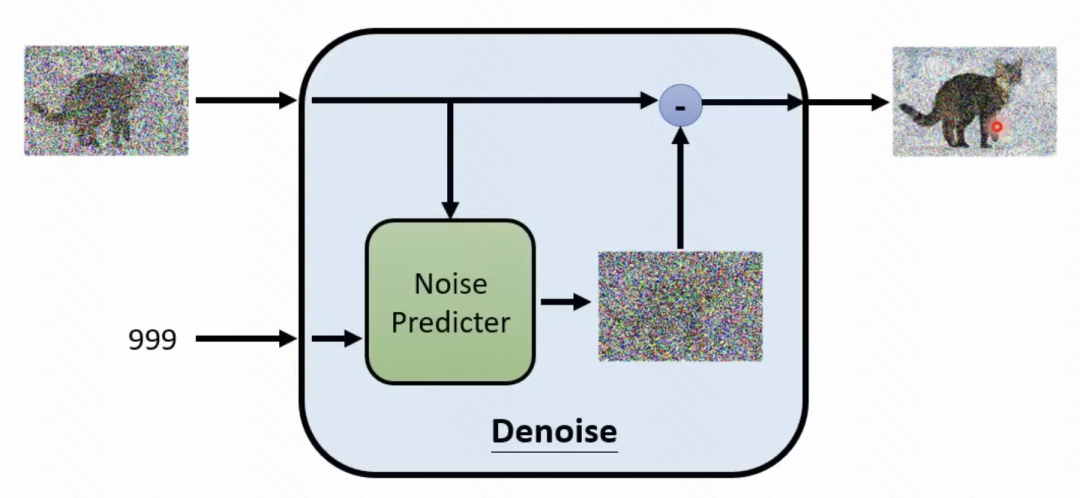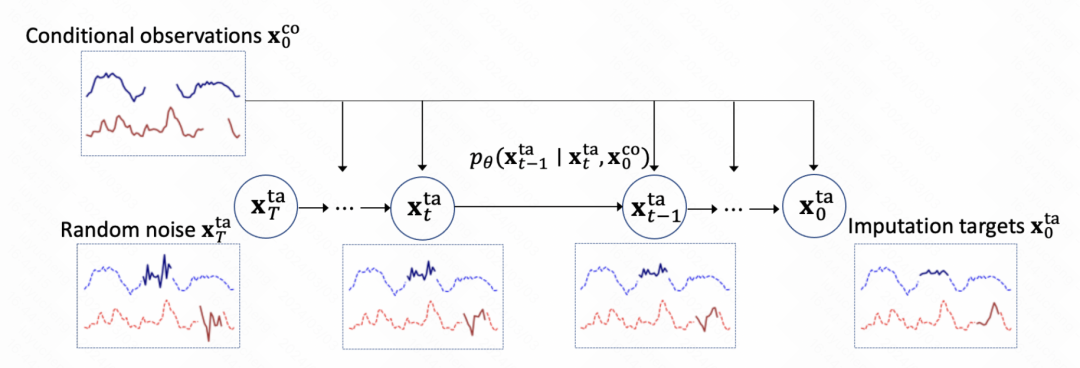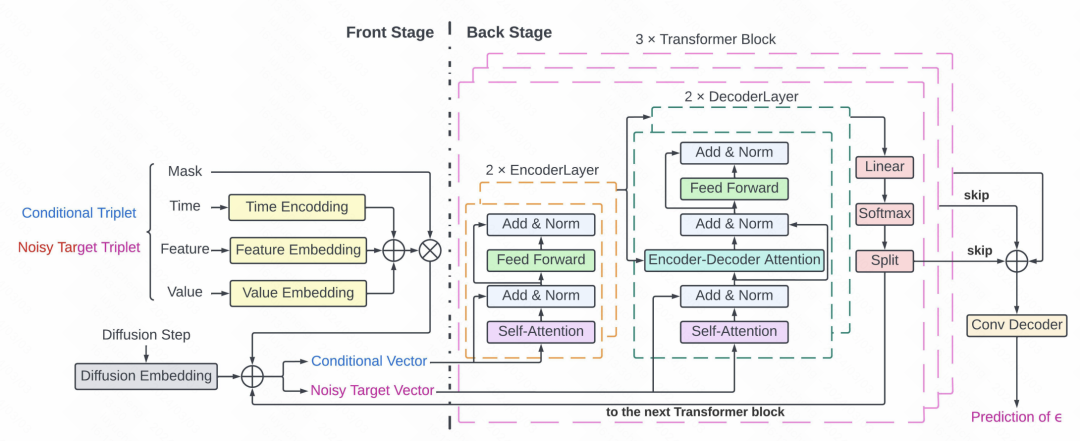 Technology peripherals
Technology peripherals
 AI
AI
 An article summarizing the application of Diffusion Model in time series
An article summarizing the application of Diffusion Model in time series
An article summarizing the application of Diffusion Model in time series
The diffusion model is currently the core module in generative AI and has been widely used in large generative AI models such as Sora, DALL-E, and Imagen. At the same time, diffusion models are increasingly being applied to time series. This article introduces you to the basic ideas of the diffusion model, as well as several typical works of the diffusion model used in time series, to help you understand the application principles of the diffusion model in time series.

1.Diffusion model modeling ideas
The core of the generative model Yes, it is possible to sample a point from a random simple distribution and map this point to an image or sample in the target space through a series of transformations. What the diffusion model does is to continuously remove noise at the sampled sample points, and generate the final data through multiple noise removal steps. This process is very similar to the sculpture process. The noise sampled from the Gaussian distribution is the initial raw material. The process of removing noise is the process of constantly chipping away the excess parts of this material.

What is mentioned above is the reverse process, that is, gradually removing noise from a noise to obtain an image. This process is an iterative process, which requires T times of denoising to remove the noise from the original sampling points bit by bit. In each step, the result generated by the previous step is input, and the noise needs to be predicted, and then the noise is subtracted from the input to obtain the output of the current time step.
Here you need to train a module (denoising module) that predicts the noise of the current step. This module inputs the current step t, as well as the input of the current step, and predicts what the noise is. This module for predicting noise is performed through a forward process, which is similar to the Encoder part in VAE. In the forward process, an image is input, a noise is sampled at each step, and the noise is added to the original image to obtain the generated result. Then the generated result and the embedding of the current step t are used as input to predict the generated noise, thereby achieving the role of training the denoising module.

2.Application of diffusion model in time series
TimeGrad is one of the earliest methods to use diffusion models for time series forecasting. Different from the traditional diffusion model, TimeGrad introduces a denoising module based on the basic diffusion model and provides an additional hidden state for each time step. This hidden state is obtained by encoding the historical sequence and external variables through the RNN model, and is used to guide the diffusion model to generate the sequence. The overall logic is shown in the figure below.

In the network structure of the denoising module, the convolutional neural network is mainly used. The input signal is divided into two parts: the first part is the output sequence of the previous step, and the second part is the hidden state output by the RNN, the result obtained after upsampling. These two parts are convolved and then added together for noise prediction.

This article uses the diffusion model to build Model time series filling task, the overall modeling method is similar to TimeGrad. As shown in the figure below, the initial time series has missing values. It is first filled with noise, and then the diffusion model is used to gradually predict the noise to achieve denoising. After multiple steps, the filling result is finally obtained.

The core of the entire model is also the diffusion model training denoising module. The core is to train the noise prediction network. Each step inputs the current step embedding, historical observation results and the output of the previous moment to predict the noise results.

Transformer is used in the network structure, including two parts: Transformer in the time dimension and Transformer in the variable dimension.

The method proposed in this article is compared to TimeGrad Going up a level, the function itself that generates the time series is directly modeled through the diffusion model. It is assumed here that each observation point is generated from a function, and then the distribution of this function is directly modeled instead of modeling the distribution of data points in the time series. Therefore, this paper changes the independent noise added in the diffusion model to noise that changes with time, and trains the denoising module in the diffusion model to denoise the function.


This article applies the diffusion model to key signal extraction in ICU. The core of this article is on the one hand the processing of sparse and irregular medical time series data, using value, feature, time triples to represent each point in the sequence, and using mask for the actual value part. On the other hand are prediction methods based on Transformer and diffusion models. The overall diffusion model process is shown in the figure. The principle of the image generation model is similar. The denoising model is trained based on the historical time series, and then the noise is gradually subtracted from the initial noise sequence in the forward propagation.

The specific noise prediction part of the diffusion model uses the Transformer structure. Each time point consists of a mask and a triplet, which are input to the Transformer and used as a denoising module to predict noise. The detailed structure includes 3 layers of Transformer. Each Transformer includes 2 layers of Encoder and 2 layers of Decoder networks. The output of the Decoder is connected using the residual network and input to the convolution Decoder to generate noise prediction results.

The above is the detailed content of An article summarizing the application of Diffusion Model in time series. For more information, please follow other related articles on the PHP Chinese website!

Hot AI Tools

Undresser.AI Undress
AI-powered app for creating realistic nude photos

AI Clothes Remover
Online AI tool for removing clothes from photos.

Undress AI Tool
Undress images for free

Clothoff.io
AI clothes remover

Video Face Swap
Swap faces in any video effortlessly with our completely free AI face swap tool!

Hot Article

Hot Tools

Notepad++7.3.1
Easy-to-use and free code editor

SublimeText3 Chinese version
Chinese version, very easy to use

Zend Studio 13.0.1
Powerful PHP integrated development environment

Dreamweaver CS6
Visual web development tools

SublimeText3 Mac version
God-level code editing software (SublimeText3)

Hot Topics
 1389
1389
 52
52
 Bytedance Cutting launches SVIP super membership: 499 yuan for continuous annual subscription, providing a variety of AI functions
Jun 28, 2024 am 03:51 AM
Bytedance Cutting launches SVIP super membership: 499 yuan for continuous annual subscription, providing a variety of AI functions
Jun 28, 2024 am 03:51 AM
This site reported on June 27 that Jianying is a video editing software developed by FaceMeng Technology, a subsidiary of ByteDance. It relies on the Douyin platform and basically produces short video content for users of the platform. It is compatible with iOS, Android, and Windows. , MacOS and other operating systems. Jianying officially announced the upgrade of its membership system and launched a new SVIP, which includes a variety of AI black technologies, such as intelligent translation, intelligent highlighting, intelligent packaging, digital human synthesis, etc. In terms of price, the monthly fee for clipping SVIP is 79 yuan, the annual fee is 599 yuan (note on this site: equivalent to 49.9 yuan per month), the continuous monthly subscription is 59 yuan per month, and the continuous annual subscription is 499 yuan per year (equivalent to 41.6 yuan per month) . In addition, the cut official also stated that in order to improve the user experience, those who have subscribed to the original VIP
 Context-augmented AI coding assistant using Rag and Sem-Rag
Jun 10, 2024 am 11:08 AM
Context-augmented AI coding assistant using Rag and Sem-Rag
Jun 10, 2024 am 11:08 AM
Improve developer productivity, efficiency, and accuracy by incorporating retrieval-enhanced generation and semantic memory into AI coding assistants. Translated from EnhancingAICodingAssistantswithContextUsingRAGandSEM-RAG, author JanakiramMSV. While basic AI programming assistants are naturally helpful, they often fail to provide the most relevant and correct code suggestions because they rely on a general understanding of the software language and the most common patterns of writing software. The code generated by these coding assistants is suitable for solving the problems they are responsible for solving, but often does not conform to the coding standards, conventions and styles of the individual teams. This often results in suggestions that need to be modified or refined in order for the code to be accepted into the application
 Can fine-tuning really allow LLM to learn new things: introducing new knowledge may make the model produce more hallucinations
Jun 11, 2024 pm 03:57 PM
Can fine-tuning really allow LLM to learn new things: introducing new knowledge may make the model produce more hallucinations
Jun 11, 2024 pm 03:57 PM
Large Language Models (LLMs) are trained on huge text databases, where they acquire large amounts of real-world knowledge. This knowledge is embedded into their parameters and can then be used when needed. The knowledge of these models is "reified" at the end of training. At the end of pre-training, the model actually stops learning. Align or fine-tune the model to learn how to leverage this knowledge and respond more naturally to user questions. But sometimes model knowledge is not enough, and although the model can access external content through RAG, it is considered beneficial to adapt the model to new domains through fine-tuning. This fine-tuning is performed using input from human annotators or other LLM creations, where the model encounters additional real-world knowledge and integrates it
 Seven Cool GenAI & LLM Technical Interview Questions
Jun 07, 2024 am 10:06 AM
Seven Cool GenAI & LLM Technical Interview Questions
Jun 07, 2024 am 10:06 AM
To learn more about AIGC, please visit: 51CTOAI.x Community https://www.51cto.com/aigc/Translator|Jingyan Reviewer|Chonglou is different from the traditional question bank that can be seen everywhere on the Internet. These questions It requires thinking outside the box. Large Language Models (LLMs) are increasingly important in the fields of data science, generative artificial intelligence (GenAI), and artificial intelligence. These complex algorithms enhance human skills and drive efficiency and innovation in many industries, becoming the key for companies to remain competitive. LLM has a wide range of applications. It can be used in fields such as natural language processing, text generation, speech recognition and recommendation systems. By learning from large amounts of data, LLM is able to generate text
 Five schools of machine learning you don't know about
Jun 05, 2024 pm 08:51 PM
Five schools of machine learning you don't know about
Jun 05, 2024 pm 08:51 PM
Machine learning is an important branch of artificial intelligence that gives computers the ability to learn from data and improve their capabilities without being explicitly programmed. Machine learning has a wide range of applications in various fields, from image recognition and natural language processing to recommendation systems and fraud detection, and it is changing the way we live. There are many different methods and theories in the field of machine learning, among which the five most influential methods are called the "Five Schools of Machine Learning". The five major schools are the symbolic school, the connectionist school, the evolutionary school, the Bayesian school and the analogy school. 1. Symbolism, also known as symbolism, emphasizes the use of symbols for logical reasoning and expression of knowledge. This school of thought believes that learning is a process of reverse deduction, through existing
 To provide a new scientific and complex question answering benchmark and evaluation system for large models, UNSW, Argonne, University of Chicago and other institutions jointly launched the SciQAG framework
Jul 25, 2024 am 06:42 AM
To provide a new scientific and complex question answering benchmark and evaluation system for large models, UNSW, Argonne, University of Chicago and other institutions jointly launched the SciQAG framework
Jul 25, 2024 am 06:42 AM
Editor |ScienceAI Question Answering (QA) data set plays a vital role in promoting natural language processing (NLP) research. High-quality QA data sets can not only be used to fine-tune models, but also effectively evaluate the capabilities of large language models (LLM), especially the ability to understand and reason about scientific knowledge. Although there are currently many scientific QA data sets covering medicine, chemistry, biology and other fields, these data sets still have some shortcomings. First, the data form is relatively simple, most of which are multiple-choice questions. They are easy to evaluate, but limit the model's answer selection range and cannot fully test the model's ability to answer scientific questions. In contrast, open-ended Q&A
 SOTA performance, Xiamen multi-modal protein-ligand affinity prediction AI method, combines molecular surface information for the first time
Jul 17, 2024 pm 06:37 PM
SOTA performance, Xiamen multi-modal protein-ligand affinity prediction AI method, combines molecular surface information for the first time
Jul 17, 2024 pm 06:37 PM
Editor | KX In the field of drug research and development, accurately and effectively predicting the binding affinity of proteins and ligands is crucial for drug screening and optimization. However, current studies do not take into account the important role of molecular surface information in protein-ligand interactions. Based on this, researchers from Xiamen University proposed a novel multi-modal feature extraction (MFE) framework, which for the first time combines information on protein surface, 3D structure and sequence, and uses a cross-attention mechanism to compare different modalities. feature alignment. Experimental results demonstrate that this method achieves state-of-the-art performance in predicting protein-ligand binding affinities. Furthermore, ablation studies demonstrate the effectiveness and necessity of protein surface information and multimodal feature alignment within this framework. Related research begins with "S
 SK Hynix will display new AI-related products on August 6: 12-layer HBM3E, 321-high NAND, etc.
Aug 01, 2024 pm 09:40 PM
SK Hynix will display new AI-related products on August 6: 12-layer HBM3E, 321-high NAND, etc.
Aug 01, 2024 pm 09:40 PM
According to news from this site on August 1, SK Hynix released a blog post today (August 1), announcing that it will attend the Global Semiconductor Memory Summit FMS2024 to be held in Santa Clara, California, USA from August 6 to 8, showcasing many new technologies. generation product. Introduction to the Future Memory and Storage Summit (FutureMemoryandStorage), formerly the Flash Memory Summit (FlashMemorySummit) mainly for NAND suppliers, in the context of increasing attention to artificial intelligence technology, this year was renamed the Future Memory and Storage Summit (FutureMemoryandStorage) to invite DRAM and storage vendors and many more players. New product SK hynix launched last year



